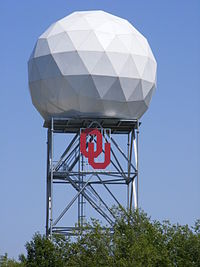This article needs to be updated. (December 2016) |





OU-PRIME (Polarimetric Radar for Innovations in Meteorology and Engineering) was an advanced Doppler weather radar. It was completed in January 2009 after a ten-month construction period and commissioned on April 4, 2009. [1] [2] It was operated by the Advanced Radar Research Center (ARRC) at the University of Oklahoma (OU). The radar was manufactured by Enterprise Electronics Corporation to provide OU students and faculty a platform for research and education in the field of radar meteorology. This C-band polarimetric radar has some of the highest resolution data of any C-band weather radar in the United States. [1] [2] [3] [4]
OU-PRIME was struck by lightning on 19 March 2012 around 9:20am local time. Since then, the radar has not been operated due to damage. [5]
System characteristics
OU-PRIME, aka OU', is located on the Research Campus of the University of Oklahoma within walking distance of the National Weather Center building. Through a unique design, OU-PRIME can provide real-time time-series data providing opportunities for rapid developments in radar signal processing algorithms. Because of its C-band wavelength and 1 MW transmit power, OU-PRIME is extremely sensitive to clouds with approximately 10 dB more sensitivity over the NEXRAD system (S-band).
Characteristics: [4]
- Location 35°10′48.8″N 97°26′0.6″W / 35.180222°N 97.433500°W
- Radiating Center Height is 80 feet (24.4 m)
- Operating frequency: 5510 MHz (C-band)
- Wavelength: 5.44 cm
- Pulse Length: 0.4, 0.8, 1.0, 2.0 µs
- Pulse Repetition Frequency: 300–2000 Hz, 1 Hz step
- 1 MW Peak Power (magnetron with solid-state modulator)
- 8.5-meter Andrew precision C-band dish
- High angular resolution: 0.45 degrees @ -3 dB points
- Gain: 50 dBi
- Sidelobe Level: Better than -26 dB one-way
- Cross-Pol: Better than -30 dB
- Rotation rate: 6-25 deg/s under typical scanning (30 deg/s max)
- Minimum Detectable Signal: -112 dBm
- Radar Sensitivity: -15 dBZ at 50 km
- Noise Figure: 3 dB
- Simultaneous dual-polarization
- Flexible computing platform for real-time algorithm development
- Real-time I/Q data recording/processing
- A/D converter resolution: 16 bit
- Receiver bandwidth: 6 MHz
- Gate spacing: 25–500 m
- Number of range gates: up to 2200
- Clutter suppression: 60 dB (automatic detection/suppression using CLEAN-AP [1])
- Advanced signal processing framework based on new STEP algorithm, including clutter estimation/suppression and multi-lag moment estimation
Research and educational pursuits
- An integral part of OU's Weather Radar Curriculum [6]
- Non-precipitating cloud studies
- Advanced signal processing algorithm development (e.g. Doppler spectrum)
- Weather radar polarimetry / QPE
- Next-generation digital receiver design
- Severe weather detection algorithms based on spectral processing
- Precipitation microphysics
- Radar-based aerobiology
- Adaptive real-time processing
- Cloud physics and electrification
- Storm dynamics
External links
- University of Oklahoma opens student access to advanced weather radar, Tulsa World, April 2009.
- New weather radar unveiled at Univ. of Oklahoma, USA TODAY, April 2009.
References
- ^ a b Advanced Radar Research Center (April 3, 2009). "THE UNIVERSITY OF OKLAHOMA TO HOLD COMMISSIONING CEREMONY FOR NEWEST RADAR" (pdf). University of Oklahoma. Retrieved 2009-04-15. [ dead link]
- ^ a b Clark Foy (January 2009). "Hi-def radar comes to South Campus". The Oklahoma Daily. Archived from the original on 2009-05-23. Retrieved 2009-04-15.
- ^ Bryan Painter (March 7, 2009). "OU-PRIME captures information from February tornado". The Oklahoman Direct. Retrieved 2009-04-15.
- ^ a b Advanced Radar Research Center. "OU-PRIME" (pdf). University of Oklahoma. Retrieved 2009-04-15. [ dead link]
- ^ https://www.accuweather.com/en/weather-blogs/weathermatrix/videos-lightning-hits-radar-power-transformers/44648
- ^ https://web.archive.org/web/20080917172519/http://arrc.ou.edu/education/